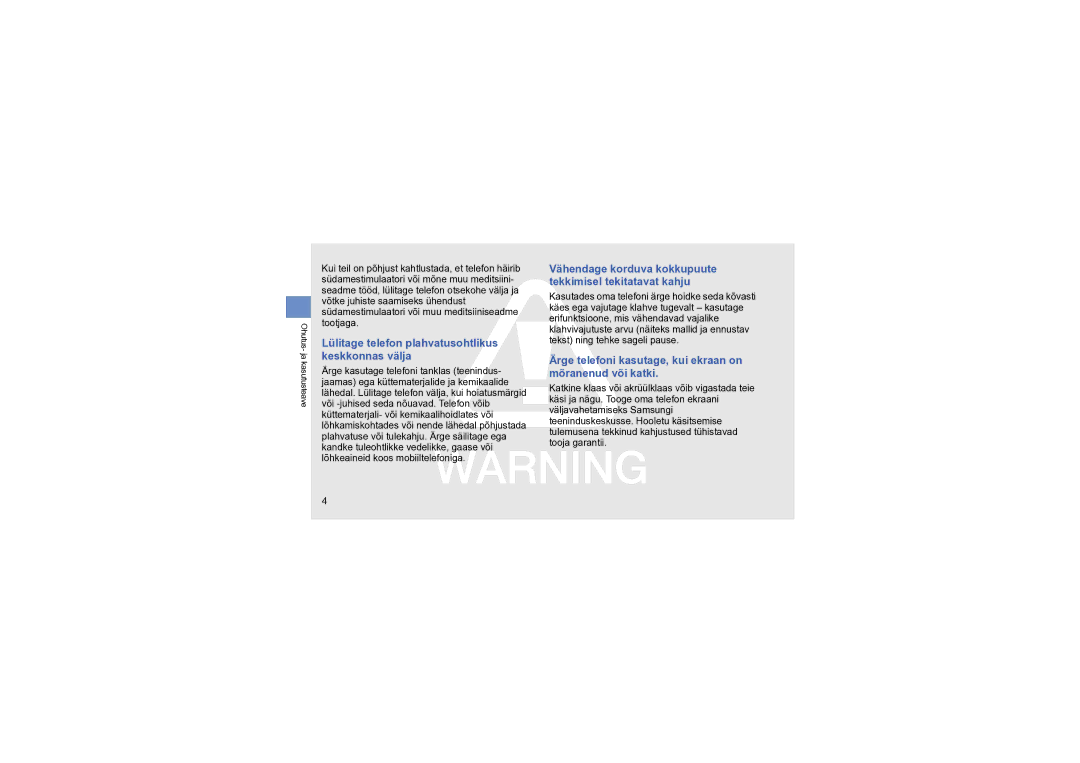Kasutusjuhend
Juhendi kasutamine
Juhendavad ikoonid
Näiteks
Teave autoriõiguse kohta
Väljumise klahvi
Teave Divx Video Kohta
Ohutusnõuded Ohutusabinõud Oluline kasutusteave
Mobiiltelefoni tutvustus
Mobiiltelefoni kokkupanek ja Ettevalmistus
Lahtipakkimine Telefoni kujundus Klahvid ja nupud Ikoonid
Põhiliste funktsioonide kasutamine
Täpsemate funktsioonide
Java-põhiste mängude ja
Hädaabisõnumi aktiveerimine ja
Telefoni ekraani vaatamine teleri
Samsungi mobiilse navigaatori
Ohutusnõuded
Kuulmise kaitsmine
Vältige südamestimulaatorite häirimist
Vähendage korduva kokkupuute tekkimisel tekitatavat kahju
Lülitage telefon plahvatusohtlikus keskkonnas välja
Ärge telefoni kasutage, kui ekraan on mõranenud või katki
Järgige kõiki ohutusnõudeid ja -eeskirju
Ohutusabinõud
Liiklusohutus eelkõige
Kasutage ainult Samsungi heaks kiidetud tarvikuid
Käsitsege telefoni ettevaatlikult ja mõistlikult
Kaitske akusid ja laadijaid kahjustuste eest
Ärge kunagi kasutage katkist laadijat või akut
Kasutage telefoni normaalasendis
Oluline kasutusteave
Vältige teiste elektroonikaseadmete häirimist
Tagage aku ja laadija võimalikult pikk tööiga
Tagage juurdepääs hädaabiteenustele
Käsitsege SIM- ja mälukaarte ettevaatlikult
Spetsiifilise neeldumismäära SAR sertimisteave
Õige viis toote kasutuselt kõrvaldamiseks
Elektriliste ja elektrooniliste seadmete jäätmed
Õige viis toote akude kasutusest kõrvaldamiseks
Lahtiütlus
Ohutus- ja kasutusteave
Ohutus- ja kasutusteave
Mobiiltelefoni tutvustus
Lahtipakkimine
Telefoni kujundus
Valimine
Klahvid ja nupud
Toide / menüüst väljumine
Ikoonid
Järgmises tabelis on kirjeldatud ekraanil kuvatavaid ikoone
Ikoon Tähendus
Mobiiltelefoni kokkupanek ja ettevalmistus
SIM- või USIM-kaardi ja aku paigaldamine
Paigaldage SIM- või USIM-kaart
Ühendage laadija väiksem ots mitmeotstarbelise pesaga
Aku laadimine
Teave tühja aku indikaatori kohta
Mälukaardi paigaldamine valikuline
Eemaldage aku kaas Avage mälukaardi hoidik
Käepaela kinnitamine valikuline
Telefoni sisse- ja väljalülitamine
Ühenduseta profiili aktiveerimine
Puuteekraani kasutamine
Rakenduste korraldamine menüürežiimis
Juurdepääs menüüdele
Telefoni menüüdele juurdepääsuks tehke järgmist
Ühelt aktiivselt rakenduselt teisele lülitumine
Rakenduste vahel ümberlülitumine
Liikumisanduri kasutamine
Rakenduste sulgemine
Rakenduste avamine klahvi Gate kasutades
Rakenduste avamine telefoni liigutades
Põhiliste funktsioonide kasutamine
Vidinate kasutamine
Näpunäited liigutustega seotud toimingute kasutamiseks
Vidinate vahetamine
Vidinate tööriistariba avamine
Vidinate teisaldamine ooterežiimi kuvale
Vidinapakettide kasutamine
Klahvitoonide helitugevuse reguleerimine
Abiteabe vaatamine
Telefoni kohandamine
Puuteekraani värina intensiivsuse reguleerimine
Helina muutmine
Vaikse profiili aktiveerimine ja desaktiveerimine
Ekraani kalibreerimine
Etiketi pausi aktiveerimine
Telefoni lukustamine
Puuteekraani avamine nutika avamise funktsiooni abil
Kõnele vastamine
Põhiliste kõnefunktsioonide kasutamine
Helistamine
Videokõne
Peakomplekti kasutamine
Helitugevuse reguleerimine
Valjuhääldifunktsiooni kasutamine
Valjuhääldi aktiveerimiseks valige kõne ajal Kõlar → Jah
Kirja saatmine
Sõnumite saatmine ja vaatamine
Tekst- või multimeediumsõnumi saatmine
Teksti sisestamine
Teksti sisestamine klaviatuuriga
Tekstisisestusmeetodi muutmine
Klaviatuur Täisekraan Kirjutusväli
Teksti sisestamine täisekraanil
Valige ooterežiimis Sõnumid → Sisendkaust
Tekst- või multimeediumsõnumite vaatamine
Kirja vaatamine
Valige ooterežiimis Sõnumid → E-posti sisendkaust
Uue kontakti lisamine
Kontaktide lisamine ja otsimine
Põhiliste kaamerafunktsioonide kasutamine
Kontakti otsimine
Fotode vaatamiseks võite kasutada üht järgmistest viisidest
Fotode vaatamine
Videoklipi salvestamine
Valige menüürežiimis Meediumi-brauser→ fotofail
Videoklipi vaatamine
Muusika kuulamine
FM-raadio kuulamine
Muusikafailide kuulamine
Ikoon Funktsioon
Veebilehtede sirvimine
Veebibrauser
Taasesituse juhtimiseks kasutage järgmisi ikoone
Otsinguga ühenduse loomine
Googlei teenuste kasutamine
Teie lemmikveebilehtede muutmine järjehoidjateks
Veebilehtedel liikumiseks kasutage järgmisi ikoone
Kaartidega ühenduse loomine
Postiga ühenduse loomine
Valige Menüü → Hangi juhised
Viimati valitud numbrile helistamine
Täpsemate kõnefunktsioonide kasutamine
Vastamata kõnede vaatamine ja tagasihelistamine
Siin on teavet helistamise lisavõimaluste kohta
Teisele kõnele vastamine
Kõne jätmine ootele või selle jätkamine
Teise kõne tegemine
Konverentskõne tegemine
Kõnest keeldumine
Rahvusvahelise kõne tegemine
Telefoniraamatus olevale kontaktile helistamine
Valige Lisa number
Lemmiknumbrite määramine
Telefoniraamatu täpsemate funktsioonide kasutamine
Nimekaardi loomine
Valige ooterežiimis Tel.rmt → Veel → Minu nimekaart
Fotode sidumine kontaktidega
Kontaktidest rühmade loomine
Fotodelt helistamine või sõnumite saatmine
Multimeediummalli loomine
Täpsemate sõnumifunktsioonide kasutamine
Tekstimalli loomine
Tekstimallide sisestamine uutesse sõnumitesse
Valige Saada
Täpsemate kaamerafunktsioonide kasutamine
Kausta loomine sõnumite haldamiseks
Valige ooterežiimis Sõnumid → Minu kaustad Valige Loo kaust
Pildistamine naeratuse võtte režiimis
Pildiseeria tegemine
Panoraampiltide tegemine
Valige → Naeratuse võte
Videote salvestamine aegluubis
Jagatud fotode tegemine
Pildistamine dekoratiivsete raamidega
Suunake kaamera objektiiv objektile
Kaamera valikute kasutamine
Valik Funktsioon
Kaamera seadete kohandamine
Seadistus Funktsioon
Muusikafailide kopeerimine mälukaardile
Täpsemate muusikafunktsioonide kasutamine
Muusikafailide kopeerimine Samsung PC Studio kaudu
Ooterežiimi naasmiseks vajutage
Esitusloendi loomine
Telefoni sünkroonimine Windows Media Playeriga
Valige menüürežiimis MP3-mängija → Esitusloendid
Laulude salvestamine FM-raadiost
Albumiloendi avamine
MP3-mängija seadete kohandamine
Salvestamise alustamiseks valige Veel → Salvesta
Raadioklipid valige menüürežiimis Minu failid → Helid
Raadiojaamade automaatne salvestamine
Muusika kohta teabe otsimine
Valige Veel → Isehäälestus
Bluetooth-funktsiooni kasutamine
Bluetooth-funktsiooni sisselülitamine
Andmete vastuvõtmine Bluetooth- funktsiooni kaudu
Teiste Bluetooth-seadmete otsing ja sideühenduse loomine
Andmete saatmine Bluetooth- funktsiooni kaudu
Valige Saatmisviis või Saada URL läbi → Bluetooth
WLAN-i aktiveerimine
WLAN-i aktiveerimine ja sellega ühenduse loomine
WLAN-i otsimine ja sellega ühenduse loomine
Meediumifailide jagamine muude seadmetega
Valige ühenduse profiil vajadusel Valige seadme ikoon
Esituse juhtimiseks kasutage telefoni ikoone
Hädaabisõnumi aktiveerimine ja saatmine
Valige kaust Valige meediumifailid
Valige Salvesta → Jah
→ Mobiilijälitus
Mobiilijälituse aktiveerimine
Telefoni ekraani vaatamine teleri ekraanilt
Valige Salvesta → Nõus
Võltskõne tegemine
Võltskõnede tegemine
Hääle salvestamine
Valige menüüs Võltskõne hääl valik Sees
Häälmemo salvestamine
Häälmemode salvestamine ja esitamine
Piltide redigeerimine
Häälmemo esitamine
Pildi muutmine
Pildi kohandamine
Valige mälu asukoht vajadusel
Käsitsi kirjutatud memo lisamine
Pildi kärpimine
Visuaalse detaili lisamine
Valige Redigeeri → Kärbi
Videoklippide redigeerimine
Piltide printimine
Segmentide lõikamine
Videoklippide tükeldamine
Heliriba lisamine
Teksti lisamine
Valige Lisalugu → Impordi heli
Lemmiksihtloendi määramine
Fotode ja videote üleslaadimine veebi
Faili üleslaadimine
Mängude või rakenduste allalaadimine
Java-põhiste mängude ja rakenduste kasutamine
Mängimine
Andmete sünkroonimine veebiserveriga
Andmete sünkroonimine
Rakenduste käivitamine
Andmete sünkroonimine Microsoft Exchangei serveriga
Valige menüürežiimis Exchange ActiveSync
RSS-kanalite kasutamine
Ainult e-kirjade sünkroonimiseks tehke järgmist
RSS-kanali aadressi lisamine
Samsungi mobiilse navigaatori käivitamine
RSS-kanalite värskendamine ja lugemine
Teie praeguse asukoha vaatamine
GPS-funktsionaalsuse värskendamine
Maailmakella loomine
Maailmakellade loomine ja vaatamine
Maailmakella vaatamine
Maailmakella lisamine telefoni ekraanile
Alarmi peatamine
Alarmide määramine ja kasutamine
Uue alarmi määramine
Alarmi desaktiveerimine
Taimeri seadistamine
Kalkulaatori kasutamine
Valuutade või mõõtühikute teisendamine
Stopperi kasutamine
Visandite loomine
Uute ülesannete loomine
Tekstimemode loomine
Uue visandi loomine
Kalendrivaate muutmine
Kalendri haldamine
Liigutuse lisamine visandile
Sündmuste loomine
Sündmuste vaatamine
Tõrkeotsing
Võrguteenustele
Sisestasite numbri, kuid kõnet ei ühendata
Telefon piiksub ja aku ikoon vilgub
Vt tööriistad, memo visand
Aku laadimine, 20 paigaldamine Tühja aku indikaator
Vt veebi- või meediumibrauser
Klahvitooni helitugevus, 31 kõne helitugevus
Vt maailmakell
Vt tööriistad, kalender
Vt tööriistad, kalkulaator
Vt telefonilukk
Vt tööriistad, RSS-kanalid
Vt tekst- või häälmemod
Vt FM-raadio
Vt tööriistad, stopper
Vt tööriistad, teisendaja
Vaatamine, 38 teksti saatmine, 36 teksti vaatamine
Vt tööriistad, taimer
Memode loomine, 83 sisestamine, 36 sõnumid
Vastavusdeklaratsioon R&TTE
Meie, Samsung Electronics
Estonian /2009. Rev

